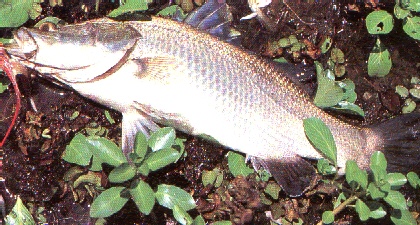
Barrimundi
(Lates Calcarifer)
 |
Common Names
Most Australians call it by it's name, or Barra. At one stage there was confusion between the Barra and the Saratoga as the Saratoga was known as the Spotted Barramundi. Also, some people call the Barra the Giant Perch, Plamer Perch and Cock-Up.
Description
The Barramundi has big scales, a large mouth, humped shoulders, a very deeply scooped forehead, and it's eyes, which are very close together, shine a bright red when hit by artificial light. There are two different colored Barramundi: the Freshwater Barra is dark bronze with brassy flanks and very dark fins and an almost black tail; the Saltwater Barra is very silver in color, and there are no other colors on it except for a purple sheen along the back of their fins and a yellowing of the tail. The Barramundi are born male and stay that way for a few years before becoming a functional female, larger in size than the male. The very big monster Barramundi are probably all gone by now. I have seen pictures of Barramundi that weigh 50 kilos; now the average size Barra taken is between 1.0 - 15.0 kilos - a big difference between this and 50 kilos! If only people undertook "catch and release" then things might be different.
Habitat
In Australia, this ranges from the Mary River in Southern Central Queensland to the Ashburton River near Onslow in Western Australia. However, the numbers are disappearing very quickly. I used to live in Queensland, 5 minute walk from the Mary River, and I have never caught a Barra. The Barra visits both freshwater and saltwater. It moves down stream to spawn during the wet season. They also love to hide around fallen trees, rocky drop-offs and mangrove gutters. In the north, they can be found in billabongs and waterholes.

Feeding
The diet of the Barra is almost as variable as its choice of habitat. It concentrates mainly on small fish, prawns, and freshwater shrimp. In saltwater they will feed on whiting, mullet, garfish, small javelin fish and prawns; sometimes they will eat crabs and squid. In freshwater, they will eat any insects and lizards, archerfish, mullet, rainbow fish. The Barra has no teeth: it kills it's prey by racing up to it, opening it's carniverous mouth and sucking in the victim and great quantities of water. It then lets the water out of it's gills and swallows the prey.
Fishing Techniques
Lures: Nilsmaster, Rebel, Barra King and swimming minnows with timber or plastic bodies. Also, saltwater flies, surface lures or anice slow sinking minnow lure - also worth a try is a rattle lure. Baits: small live mullet, live prawns - just dangling then under a float.
Fishing Tackle
A nice spinning reel - Shimano TSS4 with 10.0 kilo maxima fishing line and a BWS1609 Uglystick, lures and some size 2/0 - 8/0 hooks.
Eating
Eventhough I haven't caught one, I have eaten one. The Barra is right up at the top of the list of great fish to eat. Their fillets are firm, white and finegrained. If you happen to catch one weighing under 1.0 kilos, it should be released as there would not be much meat on it, and it will also give it a chance to change sex and spawn.
Bag Limit
Northern Territory 5 per day except in Mary river zone where it is 2 per day,Western Australia 4 per day,Queensland 5 per day.
Legal Size
Northen Territory 55cm,Western Australia-,Queensland min 58cm-max120cm closed season-midday 1 November to 1 February all Queensland.

 |
 |